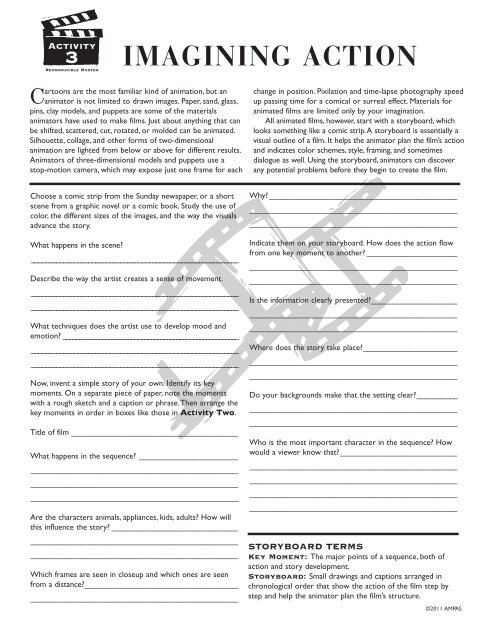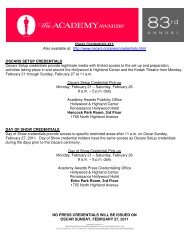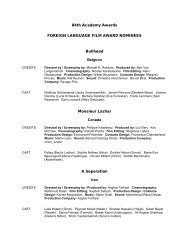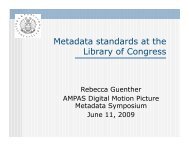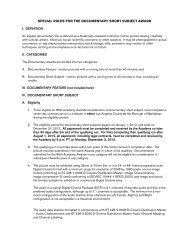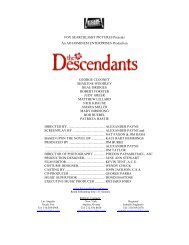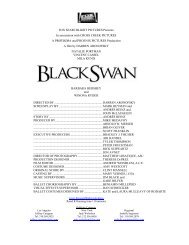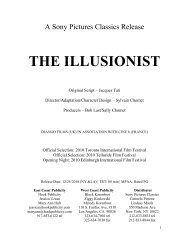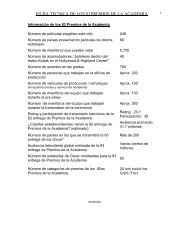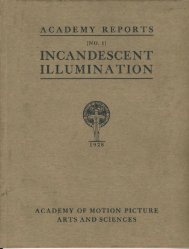CREATING MOVEMENT FRAME by FRAME - Academy of Motion ...
CREATING MOVEMENT FRAME by FRAME - Academy of Motion ...
CREATING MOVEMENT FRAME by FRAME - Academy of Motion ...
You also want an ePaper? Increase the reach of your titles
YUMPU automatically turns print PDFs into web optimized ePapers that Google loves.
Activity<br />
3<br />
Reproducible Master<br />
IMAGINING ACTION<br />
Cartoons are the most familiar kind <strong>of</strong> animation, but an<br />
animator is not limited to drawn images. Paper, sand, glass,<br />
pins, clay models, and puppets are some <strong>of</strong> the materials<br />
animators have used to make films. Just about anything that can<br />
be shifted, scattered, cut, rotated, or molded can be animated.<br />
Silhouette, collage, and other forms <strong>of</strong> two-dimensional<br />
animation are lighted from below or above for different results.<br />
Animators <strong>of</strong> three-dimensional models and puppets use a<br />
stop-motion camera, which may expose just one frame for each<br />
Choose a comic strip from the Sunday newspaper, or a short<br />
scene from a graphic novel or a comic book. Study the use <strong>of</strong><br />
color, the different sizes <strong>of</strong> the images, and the way the visuals<br />
advance the story.<br />
What happens in the scene?<br />
__________________________________________________________<br />
Describe the way the artist creates a sense <strong>of</strong> movement.<br />
__________________________________________________________<br />
__________________________________________________________<br />
What techniques does the artist use to develop mood and<br />
emotion? ______________________________________________________<br />
__________________________________________________________<br />
__________________________________________________________<br />
Now, invent a simple story <strong>of</strong> your own. Identify its key<br />
moments. On a separate piece <strong>of</strong> paper, note the moments<br />
with a rough sketch and a caption or phrase.Then arrange the<br />
key moments in order in boxes like those in Activity Two.<br />
Title <strong>of</strong> film ______________________________________<br />
What happens in the sequence? ______________________<br />
______________________________________________<br />
______________________________________________<br />
______________________________________________<br />
Are the characters animals, appliances, kids, adults? How will<br />
this influence the story? ____________________________<br />
______________________________________________<br />
______________________________________________<br />
Which frames are seen in closeup and which ones are seen<br />
from a distance?__________________________________<br />
______________________________________________<br />
change in position. Pixilation and time-lapse photography speed<br />
up passing time for a comical or surreal effect. Materials for<br />
animated films are limited only <strong>by</strong> your imagination.<br />
All animated films, however, start with a storyboard, which<br />
looks something like a comic strip.A storyboard is essentially a<br />
visual outline <strong>of</strong> a film. It helps the animator plan the film’s action<br />
and indicates color schemes, style, framing, and sometimes<br />
dialogue as well. Using the storyboard, animators can discover<br />
any potential problems before they begin to create the film.<br />
Why? __________________________________________<br />
______________________________________________<br />
______________________________________________<br />
Indicate them on your storyboard. How does the action flow<br />
from one key moment to another? ____________________<br />
______________________________________________<br />
______________________________________________<br />
Is the information clearly presented?____________________<br />
______________________________________________<br />
______________________________________________<br />
Where does the story take place?______________________<br />
______________________________________________<br />
______________________________________________<br />
Do your backgrounds make that the setting clear?__________<br />
______________________________________________<br />
______________________________________________<br />
Who is the most important character in the sequence? How<br />
would a viewer know that?__________________________<br />
______________________________________________<br />
______________________________________________<br />
______________________________________________<br />
______________________________________________<br />
STORYBOARD TERMS<br />
Key Moment: The major points <strong>of</strong> a sequence, both <strong>of</strong><br />
action and story development.<br />
Storyboard: Small drawings and captions arranged in<br />
chronological order that show the action <strong>of</strong> the film step <strong>by</strong><br />
step and help the animator plan the film’s structure.<br />
©2011 AMPAS.


